SLVAE57B February 2021 – October 2021 LM5050-1 , LM5050-2 , LM5051 , LM66100 , LM74202-Q1 , LM74500-Q1 , LM74610-Q1 , LM74700-Q1 , LM74720-Q1 , LM74721-Q1 , LM74722-Q1 , LM7480-Q1 , LM7481-Q1 , LM76202-Q1 , SM74611 , TPS2410 , TPS2411 , TPS2412 , TPS2413 , TPS2419
- Trademarks
- 1 Introduction
- 2 Reverse Battery Protection
- 3 ORing Power Supplies
- 4 Reverse Battery Protection using MOSFETs
- 5 Reverse Polarity Protection vs Reverse Current Blocking
- 6 What is an Ideal Diode Controller?
- 7 Automotive Transient protection with Ideal Diode Controllers
- 8 ORing Power Supplies with Ideal Diode Controllers
- 9 Integrated Ideal Diode Solution
- 10Summary
- 11References
- 12Revision History
2 Reverse Battery Protection
In front-end power system designs, modules, or subsystems that directly run from battery power require protection from reverse battery connection or dynamic reverse polarity conditions during a inductive load disconnect from the battery. During maintenance of car battery or jump start of the vehicle, the battery can be connected in reverse polarity during reinstallation and can cause damage to the connected subsystems, circuits, and components. Figure 2-1 shows a battery that is reverse connected. When this occurs, huge current flows through ESD diode of micro-controllers, DC/DC converters, or other integrated circuits cause severe damage to battery connected subsystems. Polarized components such as electrolytic capacitors can be damaged by reverse connected battery as shown in Figure 2-2.
 Figure 2-1 Reversed Connected
Battery: Damage to MCU or DC/DC converter
Figure 2-1 Reversed Connected
Battery: Damage to MCU or DC/DC converter Figure 2-2 Reversed Connected
Battery: Damage to Polarized Capacitors
Figure 2-2 Reversed Connected
Battery: Damage to Polarized CapacitorsPassenger cars and commercial vehicles are fitted with 12-V or 24-V battery and the subsystems powered through the 12-V or 24-V battery are subjected to various electrical transients on their power supply lines during the operating life time of the vehicle. Automotive EMC testing standards such as ISO 7637-2 and ISO 16750-2, among others, specify electrical transients, test methods, and classify functional performance for immunity against the specified transients. Reverse battery protection solution is expected to protect the electrical subsystems from the transients and meet the functional performance status required for each subsystem. Traditionally, schottky diodes are used to provide reverse battery protection and prevent damage to battery connected subsystems.